The TV show The Cosmos outlined the “Cosmic address” of where the Earth resides in the universe:
- The Solar System
- The Milky Way
- The Local Group
- The Virgo supercluster
- The observable universe
But how big are each of these and how many planets are in the universe?
Below we outline the size of each of these and review the latest assessment of the number of stars and planets in the universe.
How Many Planets Are In The Solar System?
There are 8 planets in our Solar System. These are (in order from the Sun):
- Mercury
- Venus
- Earth
- Mars
- Jupiter
- Saturn
- Uranus
- Neptune
The Sun is, of course, a star. It is one of a large number of stars in the galaxy that we are in, the Milky Way. More on this below.
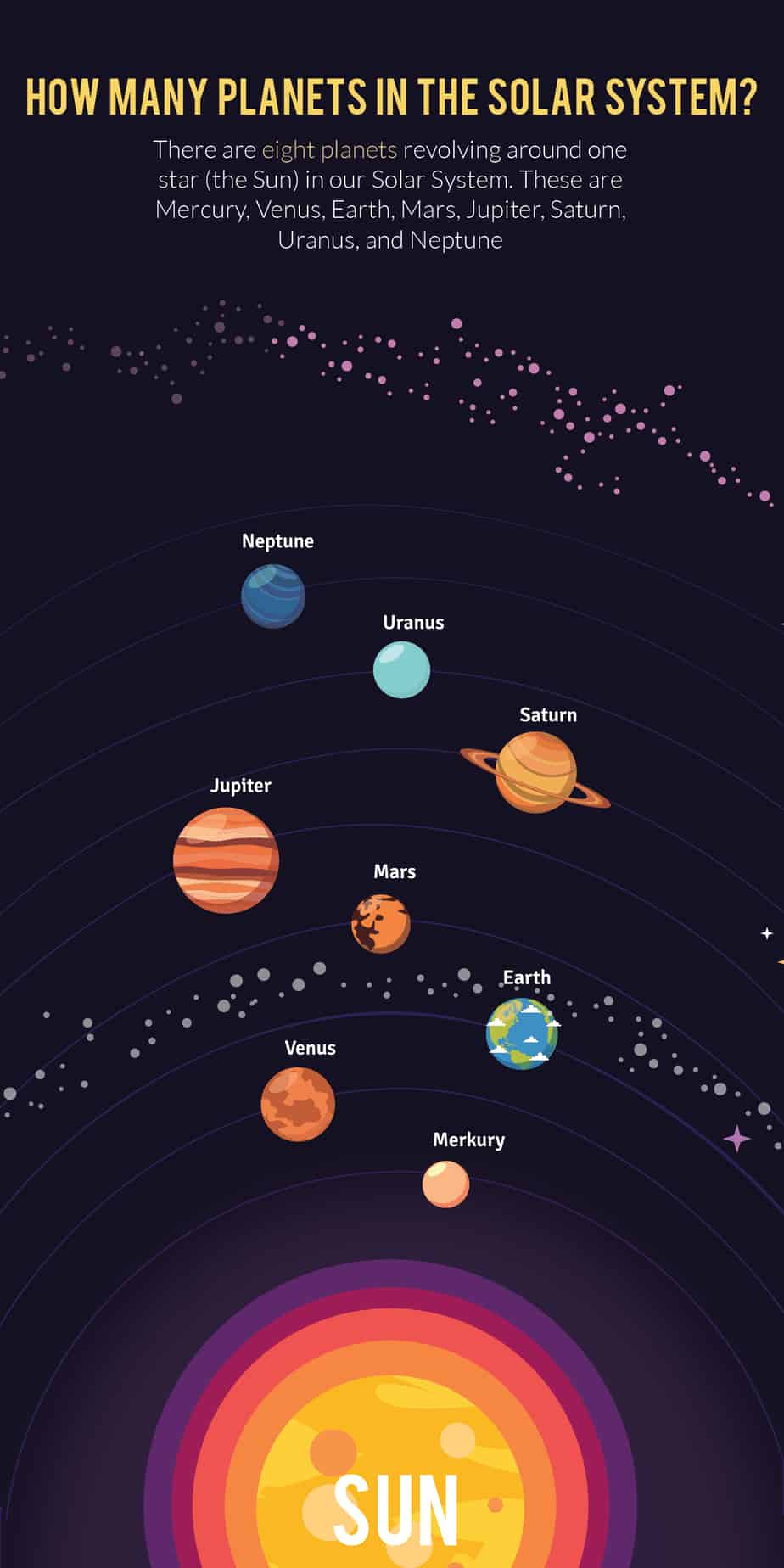
Wait, I thought there were nine planets in the solar system?
There used to be nine planets in the Solar System, with Pluto being the additional one. However, in 2006 it was downgraded and taken off the list. This was because the definition of what makes a “planet” changed and Pluto was no longer considered one, essentially because it is too small:
- When Pluto was first discovered in 1930 nobody knew how big it was. Later in the 20th century, it was discovered that it was in fact tiny in comparison to the other planets of the Solar System. It is just one-sixth the size of Earth and smaller than our moon.
- The dwarf planet Eris was discovered by the astronomer Michael E. Brown in the same area of space (the Kuiper Belt). It is larger than Pluto, but not considered a planet itself.
Pluto was therefore downgraded to a dwarf planet when an official definition of a planet was agreed by the International Astronomical Union in 2006 (see further information below).
There are four dwarf planets in addition to Pluto in our Solar System. These are Ceres, Haumea, Makemake, and Eris.
Wait, wait, didn’t I hear something about a ‘Planet 9’?
Yes, NASA’s astrophysicists have recently presented evidence that a huge and, as yet, undiscovered Planet 9 (or ‘Planet X’) probably exists at the far reaches of our solar system.
How Many Stars And Planets Are In The Milky Way Galaxy?
Given that we can’t be completely certain how many planets there are in the Solar System, it shouldn’t be too much of a surprise that once we look beyond that our estimates get much vaguer. But we are going to have a go anyway.
So, Earth and the planets of the solar system revolve around the Sun. Which is one star within our galaxy, the Milky Way.
Whilst our sun alone seems huge to us, the current best estimate is that the Milky Way contains between 100 billion and 400 billion stars (source).
Estimates vary considerably as it is extremely hard to calculate and so you can find different estimates out there (including this one estimating a trillion stars in the Milky Way).
If we then take the higher-end figure of 400 billion stars in the Milky Way, how many planets does this mean?
We know that our Sun has at least 8 planets, but the most recent analysis in Nature journal is that, on average, each star of the Milky Way hosts one planet.
Therefore we can take the estimate that there are 400 billion planets in the Milky Way.
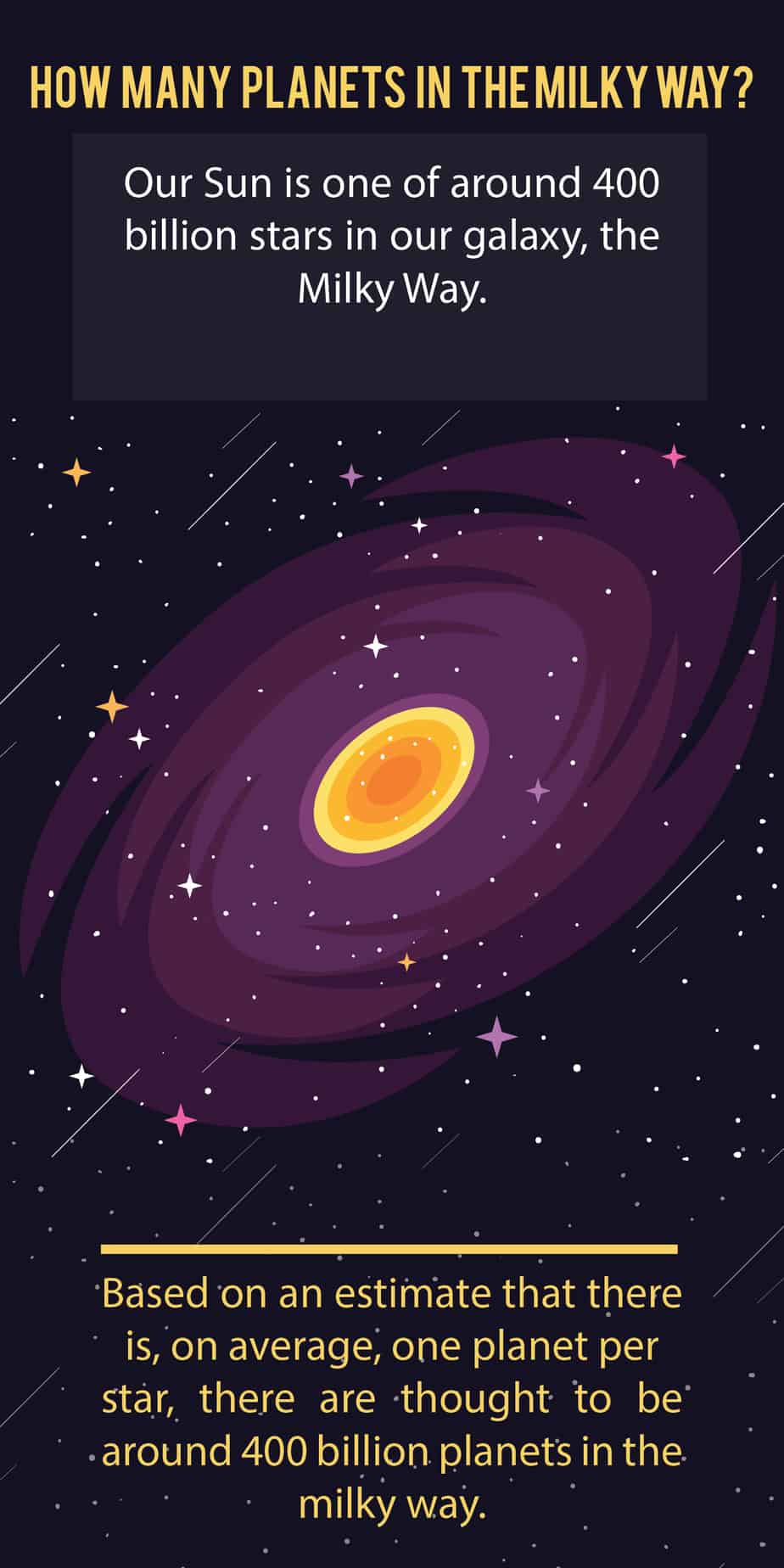
How Many Planets, Stars, And Galaxies Are There In The Local Group?
The Milky Way galaxy then resides within what is known as the Local Group.
The Local Group is an area of the universe made up of 54 galaxies, and this includes our Milky Way.
It is 10 million light-years across – to put this in context, understand that one light-year is about 9.5 trillion kilometers (5.9 trillion miles), so times that by 10 million to get the distance from one side to the other.
Just as we can only guess the number of planets in the Milky Way, estimates get even rougher as we move beyond our own galaxy.
A crude estimate would be to take the number of planets thought to be in the Milky Way and times it by 54, so this would be 54 times 400 billion, which makes an estimate of 21.6 trillion planets.
To help you get some perspective, see this zoomable image of the Andromeda galaxy taken by the Hubble space telescope.
Each dot is a sun and solar system of its own. Trying zooming in slowly and get a feel for the size of the galaxy and universe!
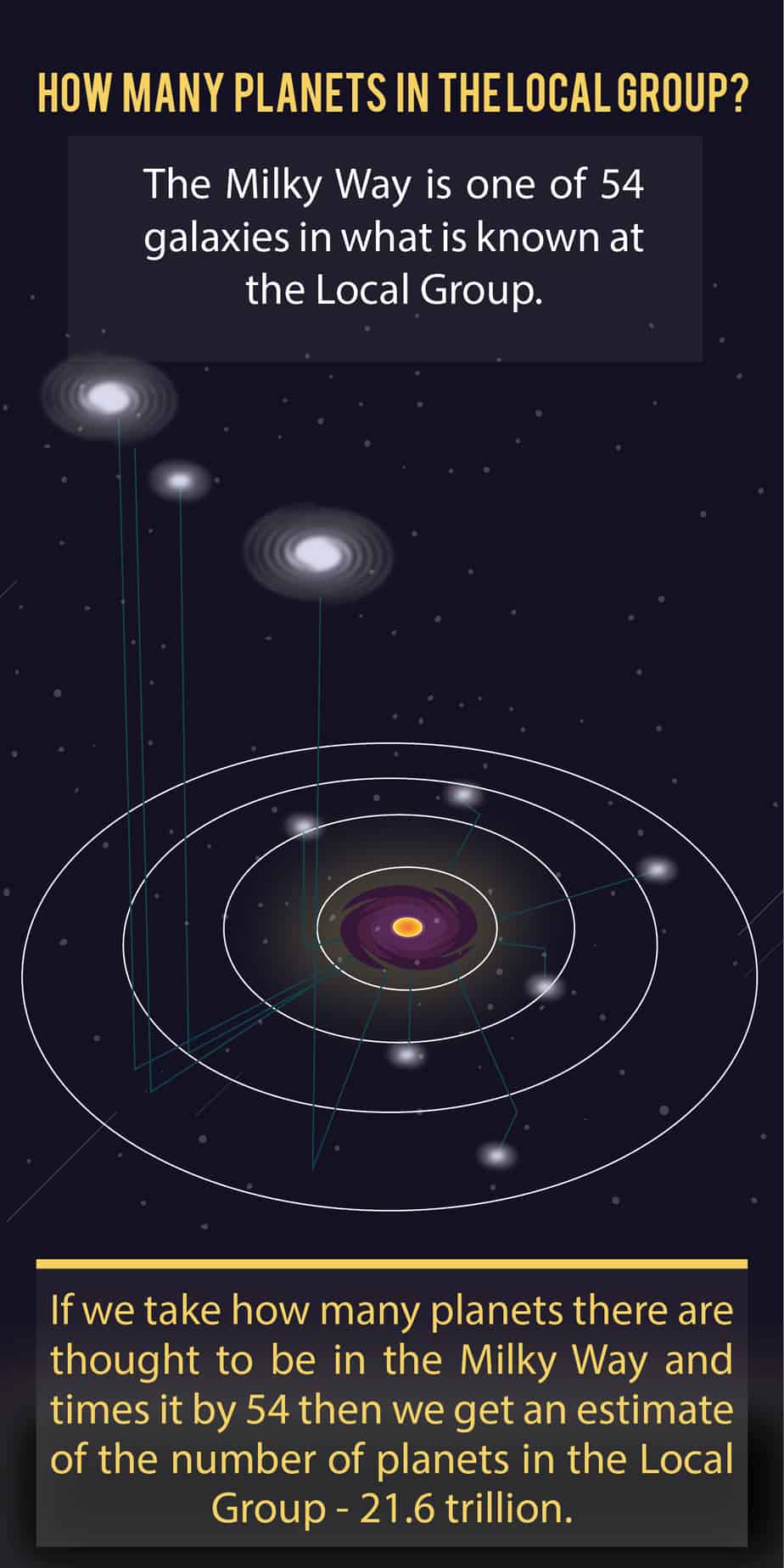
How Many Planets Are There In The Virgo Supercluster?
The Local Group then resides in the Virgo Supercluster, which is the next step on the cosmic address of the Earth.
The Virgo Supercluster comprises at least 100 galaxy groups and it has a diameter of around 110 million light-years.
Again, only very crude estimates could be made of the number of stars in the supercluster, let alone planets, but if you take the estimate of the number of planets in the Local Group (21.6 trillion) and times it by 100 (the number of galaxy groups) you get an estimate of 2.16 quadrillion planets in the Virgo Supercluster.
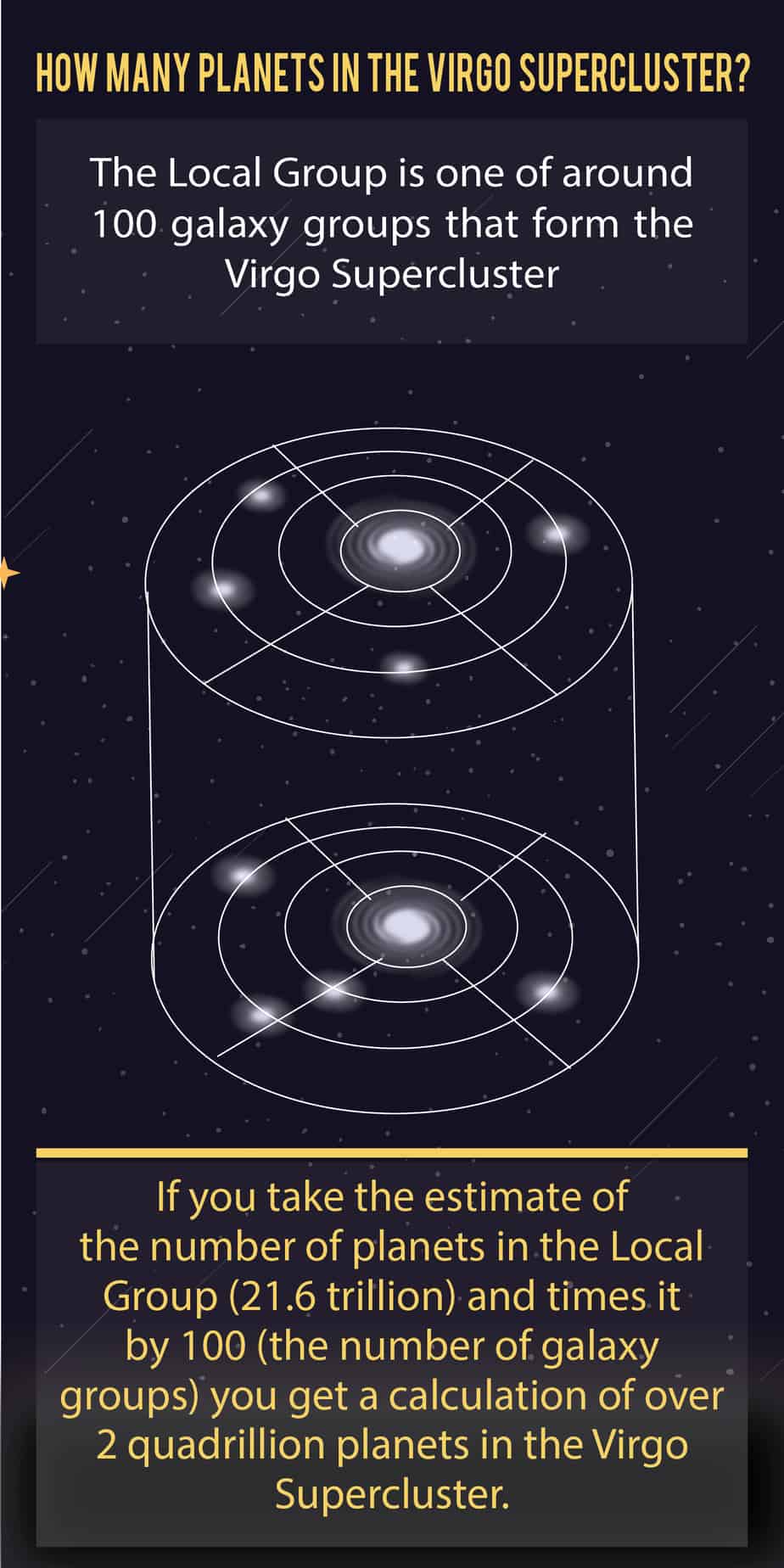
How Many Planets Are There In The Universe?
The Virgo Supercluster is then one of about 10 million superclusters in the observable universe (source).
To keep going with our estimates, this would make the number of planets in the universe 10 million times 2 quadrillion (the estimate of the number of planets in the Virgo Supercluster), which comes to 21.6 sextillion.
That’s 21,600,000,000,000,000,000,000,000 planets in the universe (2 plus 23 zeros).
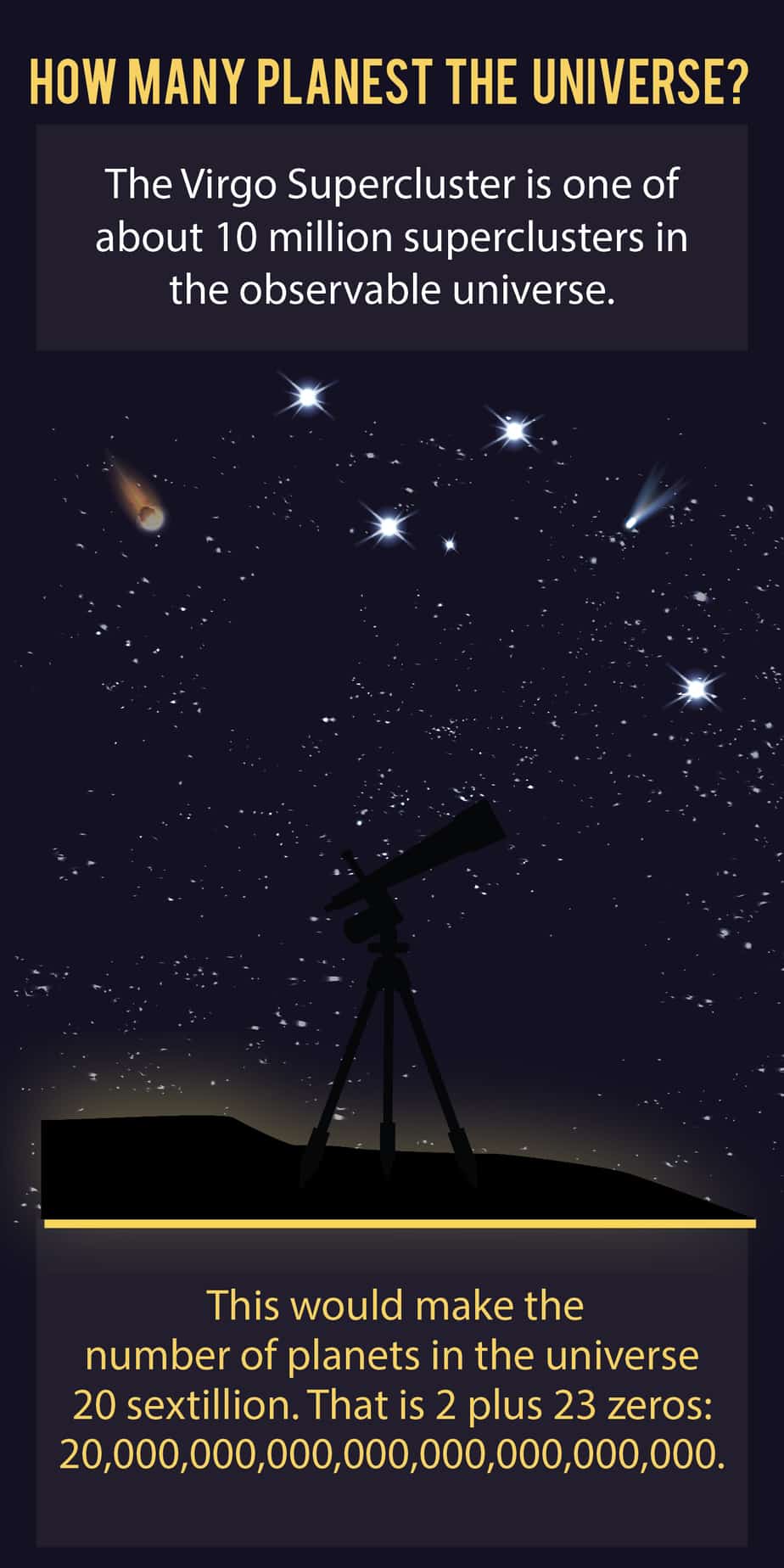
The universe vs observable universe
One further thing is that this is only for what we call the observable universe. This is the area of the universe where light from far-off objects has had time to reach Earth.
This, therefore, means there is a limit to how far we can see in any direction and the actual universe may in fact be many times the size of the observable universe. Right now we have no way of knowing.
Hubble Ultra-Deep Field
One mind-blowing illustration of the size of space is this image known as the Hubble Ultra-Deep Field (HUDF) image of a small area of space containing around 10,000 galaxies.
In this image, each of these colored specks is a galaxy like our Milky Way.
If you remember our estimates from before, they each contain 400 billion stars and 640 billion planets:
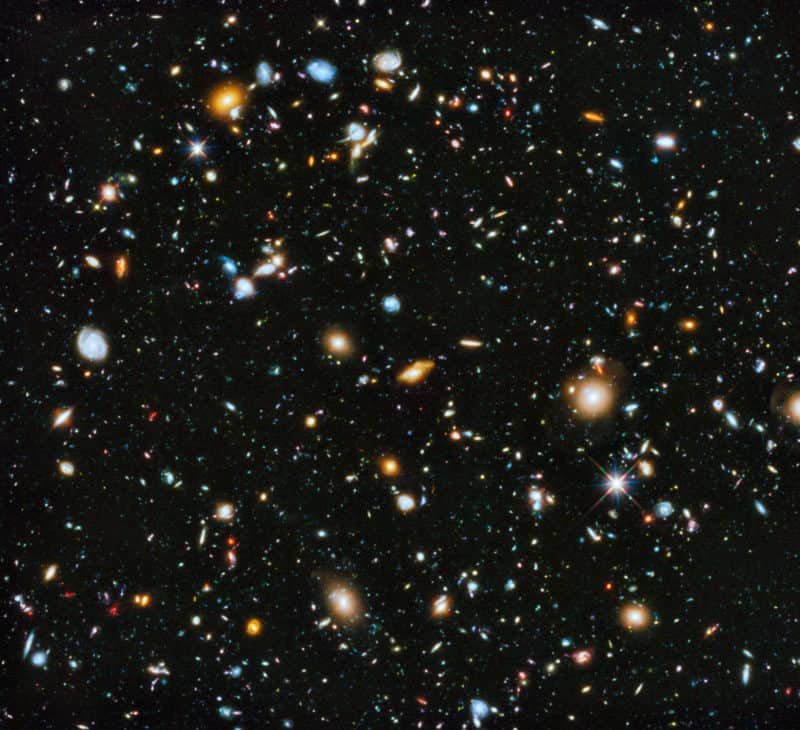
This video gives you some perspective on how small the area of space is in which this shot is taken:
Conclusion – How Many Planets are in the Universe?
So, in conclusion, the best answer we have to the question ‘how many planets are there?’ is:
- 8 planets in the solar system (maybe 9)
- 400 billion planets in the Milky Way
- 21.6 trillion planets in the Local Group
- 2 quadrillion planets in the Virgo Supercluster
- 21.6 sextillion (21,600,000,000,000,000,000,000,000) planets in the observable universe
Review the highlights of this article in the video below:
If you liked this article, find more like it in our Astronomy hub.
Bonus: Planet facts and FAQs
How many habitable planets are there?
Of all these planets, how many could humans live on?
Based on the data available, the current best guess is that there are between 5 and 10 billion potentially habitable planets in our galaxy.
This was the conclusion reached by a team of researchers at Penn State University in August 2019. They looked at numerous factors such as size, orbit times, and distance to the nearest star of planets discovered so far and extrapolated from that.
This is a huge number but bear in mind that there are thought to be around 400 billion planets in the Milky Way in total.
Therefore, this means that we are estimating between 1% and 2.5% of the planets in our galaxy are habitable.
In the known universe, there are estimated to be around 20 sextillion planets (that’s 2 plus 23 zeros). To make a calculation of how many habitable planets there might be then, we can take the estimate of 2.5% from the total number of planets (20 sextillion).
That comes to 200 quintillion, or 200,000,000,000,000,000,000.
When might we learn more about how many planets there are in the galaxy and universe?
NASA’s Transiting Exoplanet Survey Satellite (TESS) was launched on April 18, 2018, aboard a SpaceX Falcon 9 rocket.
Its mission is to discover exoplanets around nearby stars.
Currently (as of July 2021) there are 4,424 exoplanets known to us, with another 7,576 candidates awaiting confirmation (source).
What is the definition of a planet?
In 2006 the International Astronomical Union (IAU) defined that, in the Solar System, a planet is a celestial body which:
- is in orbit around the Sun,
- has sufficient mass to assume hydrostatic equilibrium (a nearly round shape), and
- has “cleared the neighborhood” around its orbit.
A body fulfilling only the first two of these criteria is classified as a “dwarf planet”. That is an object that is neither a planet nor a natural satellite, but is in direct orbit of a star and is massive enough for its gravity to crush it into a spherical shape but has not cleared the neighborhood of other material around its orbit.
With Pluto being part of the Kuiper Belt of other objects, it does not meet the third criteria for being a planet and is, therefore, a dwarf planet.
Read more about this on the IAU website.
See this NASA video on dwarf planets:
What are planets made of?
The four inner planets of the Solar System – Mercury, Venus, Earth, and Mars – are terrestrial planets composed primarily of rock and metal.
For the outer planets, Jupiter and Saturn are gas giants and Uranus and Neptune are ice giants. All four are composed mainly of hydrogen and helium but the more distant two have more ice.
What are the planets of the solar system named after?
The planets of the solar system have names derived from Greek or Roman mythology.
This is because the Greeks and Romans were the first astronomers to observe and record these planets and so named them.
The tradition was later continued by other astronomers when Uranus, Neptune, and Pluto were discovered.
- Mercury is the god of commerce, travel, and thievery in Roman mythology.
- Venus is the Roman goddess of love and beauty.
- Earth is the only planet whose English name does not derive from Greek/Roman mythology. The name derives from Old English and Germanic.
- Mars is the Roman god of War.
- Jupiter was the king of the gods in Roman mythology.
- Saturn is the Roman god of agriculture.
- Uranus is the ancient Greek deity of the Heavens.
- Neptune was the Roman god of the Sea.
As Pluto was previously classified as a planet it is also named this way – Pluto is the Roman god of the underworld.
Related articles:


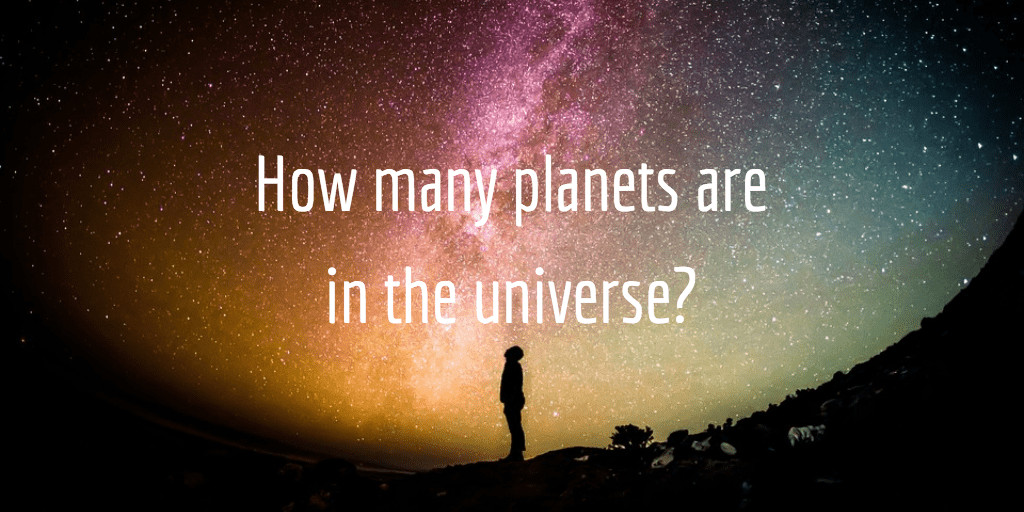

Well researched article
Thanks Nadeem!
After reading point number five and six, it was like putting my brain in a blender
Ha!
AWESOME ARTICLE/PAGE. THANKS!
Thanks Rich!
I am almost at a lost for words after reading this article due to it’s absolute a inds bsurdity! Am I the only person that finds these numbers and calculations ridiculous? You’d have too be a fool to believe any of this!
Dear Joseph you have to understand that we only estimate these numbers based on what we have ‘observed’ so far using our current technology. I am probably much older than you but when I was a child we thought that the entire universe was the Solar System with a few other stars on the outskirts. My how much our knowledge of the size of our ‘observable’ Universe has expanded in the past 60 years. Note that the key word here is ‘Observable’ ie; what we have observed using our current technology. We have no idea what the ‘unobservable’ (ie; outside the current limits of our technology) size of the Universe actually is. It may be that the ‘actual’ Universe is much much much bigger than the current estimated 23 sextillion as this is just based on the current limits of our technology. It may be that the Universe is actually infinite in size and/or completely beyond the estimation of our current or future technology.
So if this if for 2019 then what about Planet X that can be seen around the world ???
Hi Bel, no “Planet X” or “Planet 9” has been discovered yet. There are indications that such a planet does exist though. Read here for more on this: https://skiesandscopes.com/planet-9/
It’s unreal! How do I get my mind around these numbers and distances? And when do we get to meet our neighbors? So much out there, or not out there if they have disappeared since we’ve last seen their light. Just crazy! And wonderful.
Great comment! Thanks Daniel 🙂
And this is based on the Observable Universe with an assumption of one planet per Solar System. Crude analysis but your point is made, the Universe is too vast for our tiny brains to fathom. Yet here we are in the 21st century making every attempt to determine what we can possibly know. Keep up the great work educating those that need enlightenment.
Hi Steve, yes exactly, an estimate of one planet per star in the known universe. Hope we can see more accurate data in the future!
Yo you from Minecraft?
Science is the final nail in the coffins of many organized religions. His holiness the Pope in the early days of the one Holy Catholic church taught
the earth was the center of the universe with everything revolving around it. Galileo disagreed and would have been killed unless he recanted. Thousands of years before Egypt the Sumerians had all 9 planets revolving around the sun!!
What has been known for years has been kept hidden. The movie on Netflix-Unacknowledged blows the lid of all religious teachings.
A real reveal on the conspiracy theory that UFO’s are not real!!!
https://www.netflix.com/title/80171742
US has many UFO’s made using German and crashed UFO technology. Free energy has been known since the 1920’s with Tesla.
Governments and Churches are the main sources of disinformation.
Be wary of what you believe. Deception is the name of the game in which we play and we are pawns in the game.
Next question, what or where is the origin of the Universe? we will run mad trying to answer this one
All these information is beyond human mental capacity n also the capacity of any man made machine. Any theory of existence due to the vastness of the universe is applicable. In our Galaxy, there’s a enough stars to represent every single organism to ever walked this earth n therefore could mean that every stars with it planets can be dominated by at least one intelligent life form, e.g, an ant could be the top of the animal kingdom in their own solar system just as we are in our own solar system. Thinking of other galaxies n local area, existence could exist in every form contradictory of our own. There’s so so much to learn n theorerise, and we haven’t even discovered a percentage of the universe. Wow
“Oh, the depth of the riches of the wisdom and knowledge of God! How unsearchable his judgments, and his paths beyond tracing out!” [Rom 11:33]
“God’s voice thunders in marvelous ways; he does great things beyond our understanding.” [Job 37:5]
The latest modern scientist calculation of galaxies is estimated 54-10,000 galaxies only. However, there were 200 Billions galaxies in the universe.
This really helped me. Thanks.
Also, I found Bible verses that coincide with the 21.6 numbers, only with colons. I decided to look it up. I believe He knew about your findings.
Revelation 21:6
6 He said to me: “It is done. I am the Alpha and the Omega, the Beginning and the End. To the thirsty I will give water without cost from the spring of the water of life.
1 John 2:16
16 For everything in the world—the lust of the flesh, the lust of the eyes, and the pride of life—comes not from the Father but from the world.
Romans 2:16
This will take place on the day when God judges people’s secrets through Jesus Christ, as my gospel declares.
Philippians 2:16
as you hold firmly to the word of life. And then I will be able to boast on the day of Christ that I did not run or labor in vain.
Even though you said these are crude estimates, I believe there is something to it that relates to God.
God bless.
Without this, I wouldn’t really have faith right now, so thanks.
Is there more planets or more grains of sand ? Supermike 11-30-2020
email answer to me he you.re d0ne counting
There is an error in the calculation. 2 plus 23 zeros account for 16 of the number 2.16. The result is two zeros less, 216,000,000.000000.000.000.000.
Sorry to burst bubbles, but there are two glaring errors in the graphic labeled, “This would make the number of planets in the universe 20 sextillion.”.
The first is that there are only 22, not 23, zeroes after the number 2; and second, the representation of the number 20 sextillion is 20,000,000,000,000,000,000,000 or three zeroes LESS than shown.
This, according to “https://en.wikipedia.org/wiki/Names_of_large_numbers”.
➡10Q very much!
I earned new knowledge from this explanation!
be continue to so!
21.6 sextillion planets? Surely, there must be intelligent life on SOME of them!
Thanks for this information. It’s wonderful to know that even the status of a planet can change. Of a truth, Change is the only constant thing in life.
With much love!
The author seems a bit confused about large numbers:
Quote:
“That’s 21,600,000,000,000,000,000,000,000 planets in the universe (2 plus 23 zeros)”
First of all, 21,600,000,000,000,000,000,000,000 is approximately 2×10^25 (2 pluss 25 zeros), not 2×10^23 (2 pluss 23 zeros).
Secondly, neither 2×10^23 nor 2×10^25 equals 20 sextillion.
2×10^23 is 200 sextillion, and 2×10^25 is 20 septillion.
20 sextillion would be 2×10^22.
So, the author uses three widely different numbers for the number of planets in the universe, which is a shame, since the number of planets i the universe is basically what the article is supposed to tell us.
I liked your site very much. I will definitely come and visit it again.
Thanks bro!
Every time I read one of your posts, I come away with something new and interesting to think about. Thanks for consistently putting out such great content!